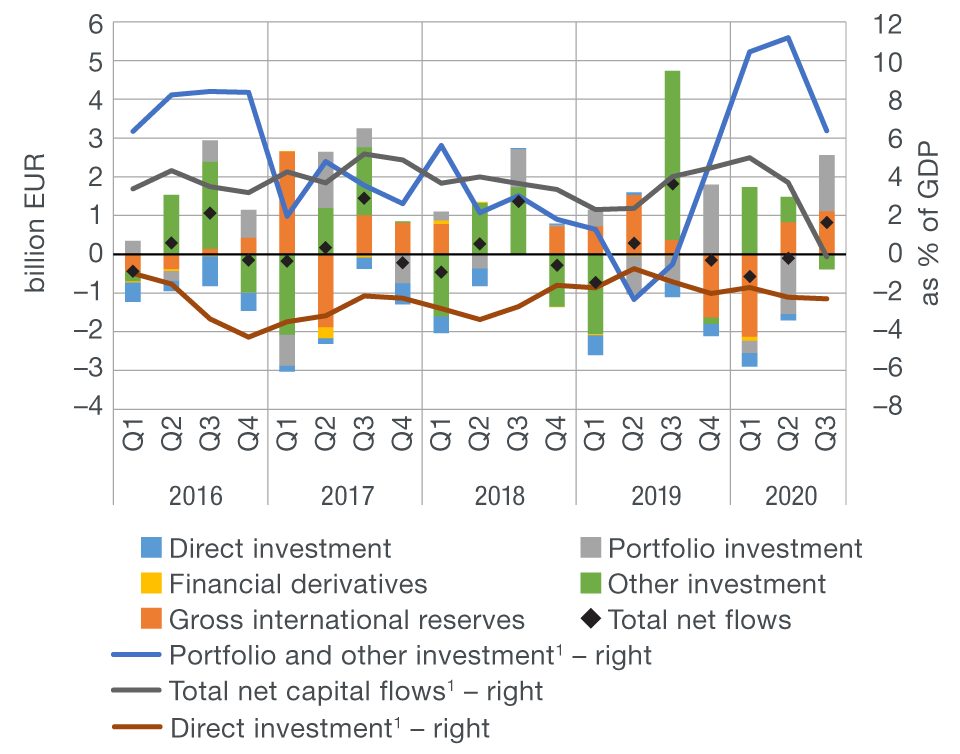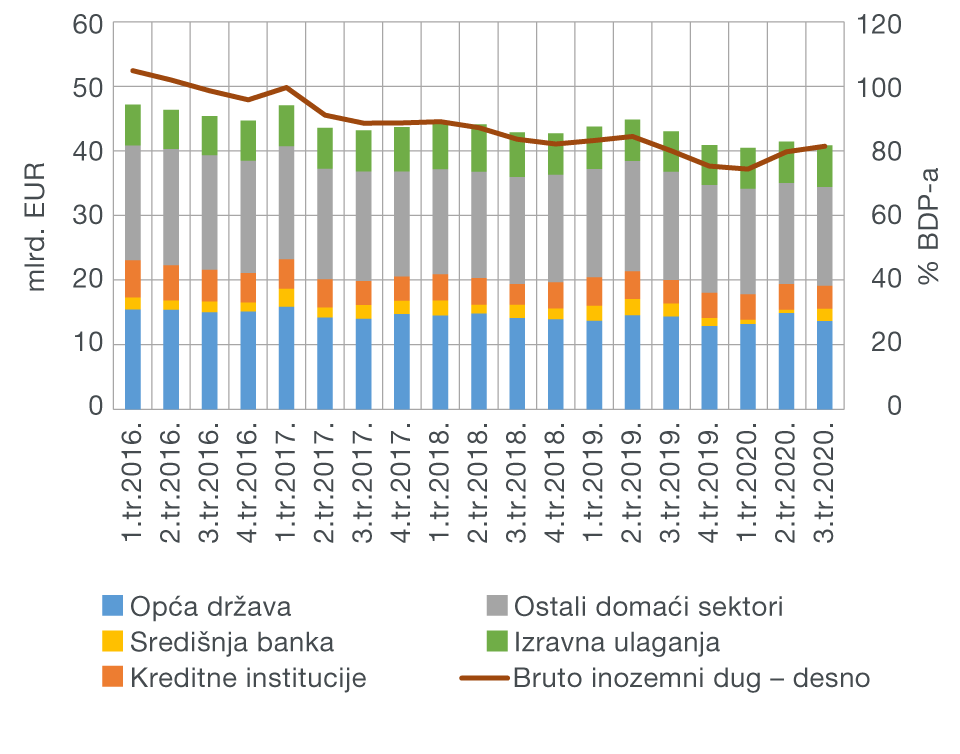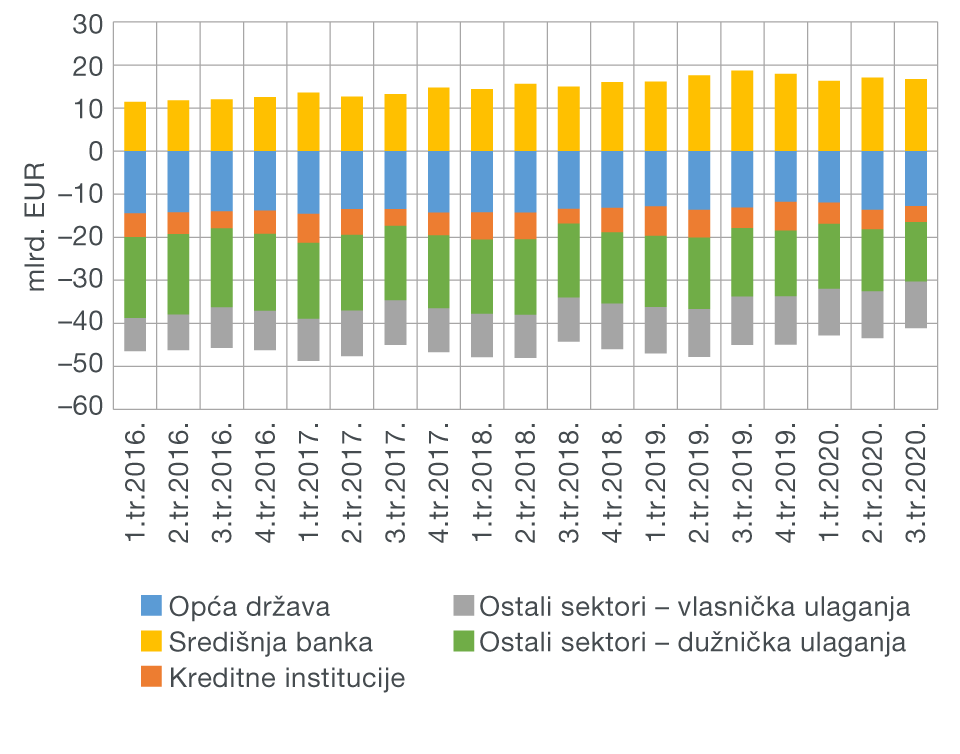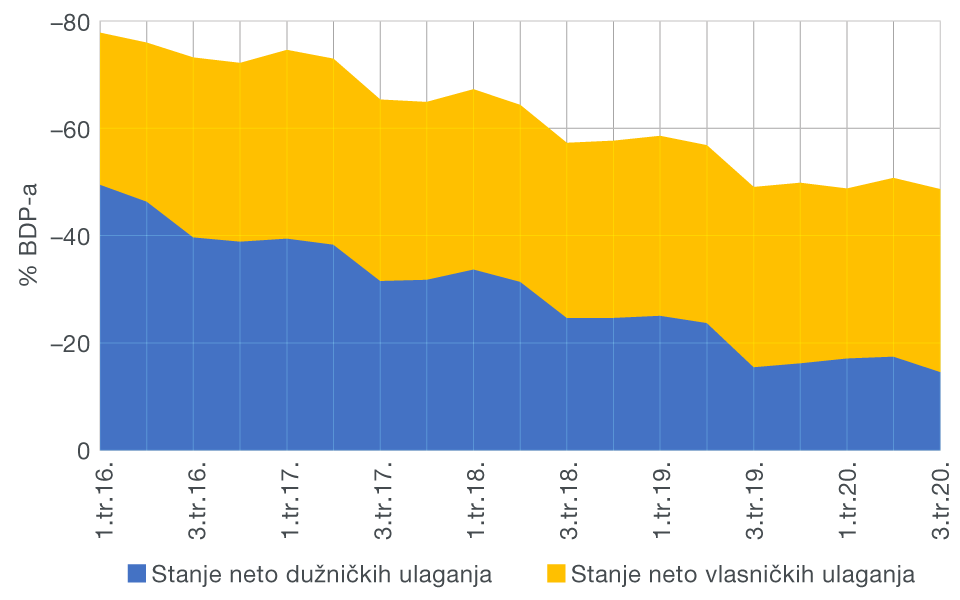From August 2023 the comments on statistics, a short description of selected, recently issued statistical data in the area of monetary statistics and the non-residents sector statistics, are no longer published. They are replaced by Statistical releases.
Comments on the balance of payments, gross external debt and the international investment position in 3Q 2020
The current and the capital account of the balance of payments accrued a surplus of EUR 2.2bn
in the third quarter 2020, which was a deterioration of EUR 2.6 bn from the same period of the previous year. If the last four quarters are observed, the surplus in the current and capital account in the period up to the end of September 2020 totalled 0.8% of GDP, which was a decrease of 4.0 percentage points from the entire 2019.
At the end of September 2020, gross external debt stood at EUR 40.9bn, down EUR 0.6bn from the end of June. However, the relative indicator worsened by 1.7 percentage points due to the strong fall in nominal GDP and stood at 81.4% of GDP at the end of September. By contrast, the ratio of net international investment position to GDP improved from –50.7% at the end of the second to –48.7% at the end of the third quarter of 2020.
After a mild worsening in the second quarter, the balance in the current and capital account of the balance of payments strongly deteriorated in the third quarter of 2020. This was primarily due to the strong concentration of revenues from the tourist spending of foreign guests during the summer months, which decreased noticeably this year. Thus, the current and capital account of the balance of payments registered a surplus of EUR 2.2bn in the third quarter, down as much as EUR 2.6bn from the same period of the previous year (Figure 1a). The unfavourable developments caused by the strong fall in net services exports were partially mitigated by the improvement in the balance in other accounts, that is, by the decrease in the merchandise trade deficit and the improvement in the primary income account. At the same time, total surplus in the secondary income and capital transaction accounts rose slightly. If the last four quarters are observed, the surplus in the current and capital account in the period up to the end of September 2020 totalled 0.8% of GDP, as much as 4.0 percentage points less than in the entire 2019 (Table 1).
The third quarter of 2020 registered a strong decrease in net services exports (EUR 3.1bn) compared to the same period of the previous year, primarily caused by the sharp fall in revenues from tourist spending of foreign guests, which went down 49.0%, due to the restrictive epidemiological measures introduced to contain the coronavirus pandemic, decline in disposable income and changes in consumer behaviour. By contrast, unfavourable developments in the trade of services were partly mitigated by the decrease in the merchandise trade deficit (EUR 0.3bn). Namely, although there was a considerable fall in the exports of goods (8.7%), the contraction in imports was even more prominent, totalling 10.6%, which together with the noticeably larger imports base resulted in the strong reduction of the deficit (13.1%)
The balance in the primary income account improved by EUR 0.2bn in the third quarter 2020 from the same period of the previous year, as a result of smaller expenditures on direct equity investments, i.e. decline in profits of foreign-owned banks and enterprises (primarily in accommodation activities, real estate activities and oil industry). On the other side, net revenues from compensation of persons temporarily employed abroad decreased by 17.3%, similarly as in the previous quarter, after having grown almost uninterruptedly from the second half of 2014.
The total surplus in the secondary income and capital transaction account rose slightly in the third quarter of 2020 from the same period in the previous year (EUR 39m). Namely, the favourable impact of the growth in surplus in net transactions with the EU budget was largely offset by the decrease in net revenues from personal transfers.
Figure 1 Balance of payments
| a) Current and capital account | b) Financial account |
 |
|
1 The sum of the last four quarters.
Note: In the figure showing the financial account, the positive value denotes net capital outflow abroad and the negative value denotes net capital inflow.
Source: CNB.
The financial account of the balance of payments recorded a net capital outflow of EUR 1.6bn in the third quarter of 2020, which is a decrease of EUR 2.0bn from zthe same period of the previous year (Figure 1b). The considerable decrease in net outflow reflects the earlier described deterioration of developments in the current and capital account. Broken down by individual accounts, a considerable net capital outflow was recorded in the portfolio investment account (EUR 1.4bn), while, on the other side, net capital inflow was recorded in the other investment account (EUR 0.4bn) and in the foreign direct investment account (EUR 0.3bn). At the same time, gross international reserves increased noticeably (EUR 1.1bn), almost reaching the level from the end of 2019 by the end of September. However, such developments were strongly influenced by the increase in the volume of repo agreements of the central bank abroad which raised the gross international reserves and liabilities of the central bank in the other investment account by EUR 1.4bn.
The net capital outflow in the portfolio investment account was primarily a consequence of the July repayment of the government bond, worth USD 1.25bn, issued in 2010, after the government issued a new international bond in June for the purpose of refinancing the bond and financing counter-crisis measures. The government sold the largest portion of foreign exchange from the June issue to the central bank and the remaining share partly deposited to its account with the central bank. The withdrawal of the deposit in July mitigated the earlier described growth of gross international reserves caused by the increase in the volume of repo agreements. Nat inflow of capital registered in the other investment account was exclusively a result of the increase in foreign liabilities of the central bank due to earlier mentioned noticeable growth in the volume of repo agreements, while liabilities of other sectors decreased (EUR 0.6bn). In addition the assets of domestic sectors increased (EUR 0.4bn) especially due to the usual seasonal increase in foreign assets of credit institutions, although less pronounced than in the same period over the previous years due to a much weaker inflow of foreign exchange in the peak tourist season.
The net inflow of capital in the foreign direct investment account was to the largest extent a result of retained profit of foreign-owned domestic banks and non-financial corporations (despite the noticeable decrease compared to the same period of the previous year), as well as the inflow of new equity investments in Croatia. Namely, after there were no direct equity investments in the previous quarter, in the third quarter they were only slightly lower than in the same period of the previous year and were predominantly realised thanks to investments in real estate and computer programming activities.
Table 1 Balance of payments
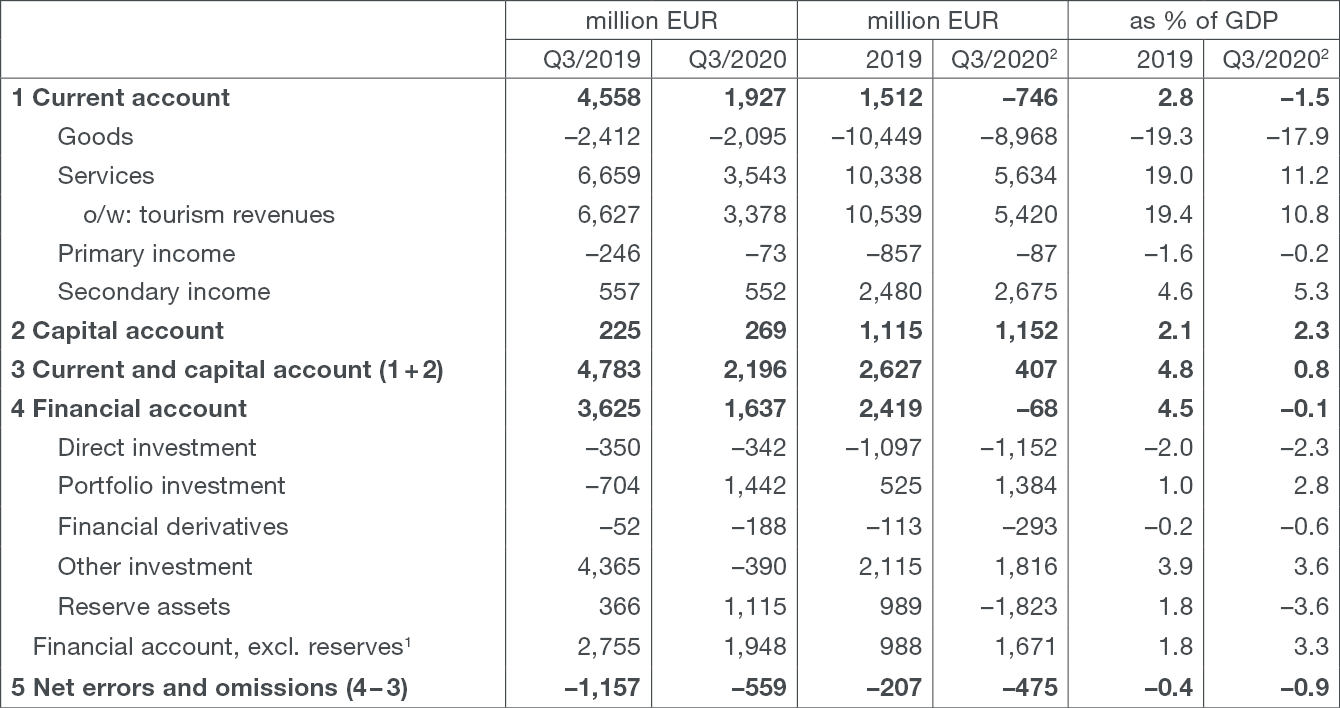
1 Excluding the change in the gross international reserves and foreign liabilities of the CNB. The investment of a portion of international reserves in reverse repo agreements results in a simultaneous change in CNB assets (recorded in the reserve assets account) and liabilities (recorded in the other investment account) and thus has a neutral impact both on changes in the central bank's net foreign position and the overall financial account balance.
2 The sum of the last four quarters.
Note: The positive value of financial transactions denotes net capital outflow abroad and the negative value denotes net capital inflow.
Source: CNB.
The stock of gross external debt decreased by 0.6bn in the third quarter of 2020. Broken down by sector (Figure 2a), the decrease in total debt was primarily aided by the government (EUR 1.2bn) with the earlier mentioned bond repayment. In addition, credit institutions reduced their debt (EUR 0.4bn) and so did other domestic sectors, including their liabilities to affiliated creditors (EUR 0.4bn). By contrast, due to earlier mentioned increase in volume of repo agreements, the gross debt of the central bank increased (EUR 1.4bn). Accordingly, total gross external debt stood at EUR 40.9bn at the end of September 2020, i.e. at 81.4% of GDP, which was, due to the strong fall in the nominal GDP, 1.7 percentage points more than at the end of June (Figure 2b). At the same time, net external debt decreased by EUR 2.2bn, totalling EUR 7.9bn at the end of September, or 15.8% of GDP, which is 3.6 percentage points less than three months earlier.
Figure 2 Gross external debt
| a) Change in gross external debt | b) Stock of gross external debt |
|
|
|
Note: Changes in gross external debt are a result of net transactions of domestic sectors and exchange rate and other adjustments.
Source: CNB.
The strong decrease in net external debt resulted in a noticeable improvement of the net international investment position, from EUR –26.4bn at the end of the second to EUR –24.4 bn at the end of the third quarter 2020. The net foreign position of the government and banks improved, and to a lesser degree, so did that of other domestic sector, while only the net foreign position of the central bank deteriorated (Figure 3a). The relative indicator of the net international investment position improved by 2.0 percentage points from the end of June and ended September at –48.7% of GDP (Figure 3b).
Figure 3 International investment position (net)
| a) Position by sector | b) Relative indicator by type of investment |
|
|
|
Note: The international investment position equals the difference between domestic sectors' foreign assets and liabilities at the end of a period. The negative value of the net international investment position indicates that foreign liabilities of Croatian residents are greater than their foreign assets. Included are assets and liabilities based on debt instruments, equity investments, financial derivatives, and other instruments. Figure 3b includes financial derivatives and other liabilities in the net debt investment position.
Source: CNB.
Data revision
Data on the balance of payments, gross external debt and the international investment position are revised in accordance with the commonly used practice, based on subsequently available data.
Detailed balance of payments data

